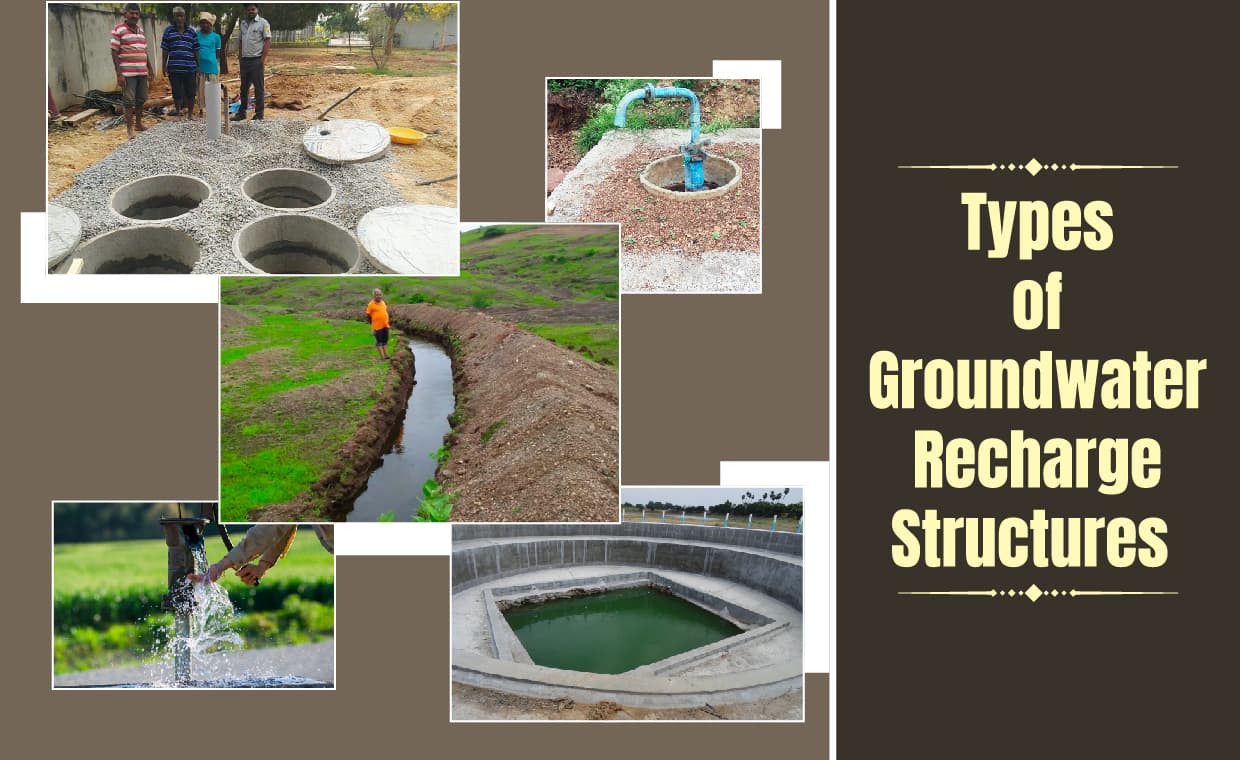
Have you ever felt inconvenienced when the water supply suddenly disrupts your household chores? A few challenges have been faced in achieving adequate water quantity, because of water depletion, groundwater pollutants, and drinking water shortage. This is when the need for recharge structures comes into play. Rainwater harvesting for groundwater recharge involves the injection of rainwater into the aquifer through trench cum tube wells under gravity flow.
In this article, let us explore the various types of groundwater recharge structures.
Various Types of Recharge Structures
The groundwater recharge setup needed in the area depends on the type of soil, the available land area, and the water sources available there. However, the only thing to remember here is to not allow the runoff from the first rain to percolate into the rainwater harvesting structure. Instead, let it drain by making suitable bypass arrangements in the water-carrying pipe system. There are different methods for rainwater recharge, which include:
01. Recharge through Unused Dug Well

A dry or unused dug well can serve as a recharge structure. The recharge water passes through a pipe to the bottom of the well or below the water level to avoid scouring the bottom and entrapment of air bubbles in the aquifer. Before using the dug well as a recharge structure, ensure that its bottom is clean and free of fine deposits.
Recharge water should be silt-free as much as possible. It is suitable for large buildings with a roof area of more than 1000 sqm.
02. Recharge Through the Hand Pump

Running hand pumps can be used for recharge. The structure is suitable for a small building with a roof area of 150 Sqm. A pipe of 50 to 100mm-diameter diverts the water from the rooftop to the hand pump. For running the hand pump, a closing valve is fitted in the conveyance system near the hand pump to avoid air entering the suction pipe. Recharge water should be silt-free.
03. Recharge Pit

Recharge pits of about 1 to 2m and 2-3m depth are constructed for recharging the shallow aquifer. After excavation, the pits are filled with pebbles and boulders. Water flowing in should be silt-free as far as possible. Annual cleaning of the pit is preferable.
It is suitable for small buildings with a rooftop area of up to 100 sqm. The recharge pit may be of any shape. i.e. circular, square, or rectangular. If the pit is trapezoidal, the side slopes should be steep enough to avoid silt deposition.
04. Recharge Through Rainwater Harvesting Trench

This kind of shallow trench depth filled with pebbles and boulders is best suited when permeable strata of adequate thickness are available at shallow depths. These are constructed across the land slope. The trench may be 0.5 to 1m wide 1 to 1.5m deep and 10to20m long, depending on the availability of land and rooftop area. It is suitable for buildings with a roof area of 200 to 300 Sqm. The trench requires periodic cleaning.
05. Gravity Head Recharge Tube Well

If there is limited space and deep aquifers are covered by impermeable layers, borewells or tube wells become ideal recharge structures. The rooftop rainwater is channelised to the well and recharged under gravity flow conditions. It’s important to ensure the recharge water is free of silt.
The well can also be used for pumping, making it a versatile solution in areas with deep groundwater levels. The number of recharging structures required in a space depends on the rooftop area and the specific characteristics of the aquifer.
06. Recharge Shaft

One can dig a recharge shaft manually or drill it using the reverse/direct rotary method. The diameter of the recharge shaft varies from 0.5 to 3m depending on the availability of water. It is best suited where the shallow aquifer is located below the clayey surface.
The recharge shaft is backfilled with boulders, gravel, and coarse sand. It should end in more permeable strata. The depth of the recharge shaft varies from 10-15m below ground level. Always construct the recharge shaft 10 to 15m away from buildings for the safety of the building. It requires annual cleaning, preferably by scraping the top layer of sand and refilling it accordingly.
Maintenance of Recharge Structures
Even after filtration, surface water can still clog recharge wells relatively quickly. While filters help, there’s chance fine particles may pass through and cause issues.
Regular pumping for short durations can help remove clogging particles, improving the recharge capacity of the well. To further enhance this, consider annually redeveloping the recharge well using an air compressor. This process helps clear out built-up clogs and improve water flow. Additionally, periodic scraping of the finer material trapped within the well is recommended for optimal performance.
The whole complex can be strategically divided into various clusters, and one of the above systems appropriate to the roof size and underground characteristics may be selected for use.
We hope this blog on various rainwater recharge structures helps you make a decision.
In addition, we have also written an interesting blog on rainwater harvesting solutions.
Image Courtesy : Image 2, Image 3, Image 4, Image 5, Image 6, Image 7
Author Bio
Bhamini Gamit – I’m Bhamini Gamit. I had completed my graduation in 2019 from S.N.P.I.T & R C, Umrakh, Surat, Gujarat. My core interest is to write blogs on civil engineering of various subjects like geotechnical, Building materials, Building construction, and Reinforcement cement concrete. For the last 6 months, I have been a guest writer on Gharpedia. You can easily find me on Instagram & LinkedIn.






























